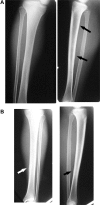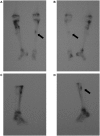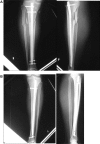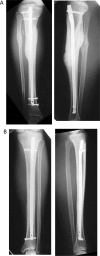A complete posterior tibial stress fracture that occurred during a middle-distance running race: a case report
- PMID: 30194512
- PMCID: PMC6342873
- DOI: 10.1007/s00402-018-3035-5
A complete posterior tibial stress fracture that occurred during a middle-distance running race: a case report
Abstract
Posterior tibial stress fractures are more frequent than anterior tibial stress fractures, and they are considered to have a good prognosis for returning to sports; cases leading to a complete fracture are rare. A 17-year-old male involved in high school athletics middle-distance running had a 3-week history of pain with training. He was running up to 300 km/week on streets and cross-country in an even distribution. He had posterior tibial stress fractures, but despite the lower leg pain, he continued running. One year later, he was brought to the emergency department after having sustained an injury to the right lower leg while running in a middle-distance race; bilateral tibial stress fractures, with one side complete and the opposite side incomplete, had developed simultaneously. This relatively rare case of bilateral posterior stress fractures, with one side a complete fracture and the opposite side an incomplete fracture, that was treated surgically via exchange intramedullary nailing is reported. The patient could begin light jogging from 3 months after surgery and was without symptoms at 5 months after surgery. He could resume middle-distance racing after 1 year. Posterior tibial cortical fractures are more common and respond better to conservative treatment than anterior tibial stress fractures, and they are a common fracture type in runners. We believe that close, careful follow-up is necessary if patients continue excessive training.
Keywords: Intramedullary nailing; Overuse injuries; Posterior tibial stress fracture; Runner-type stress fracture; Running; Stress fractures.
Figures








References
-
- Ballas MT, Tytko J, Cookson D. Common overuse running injuries: diagnosis and management. Am Fam Physician. 1997;55(7):2473–2484. - PubMed
Publication types
MeSH terms
LinkOut - more resources
Full Text Sources
Other Literature Sources
Medical

